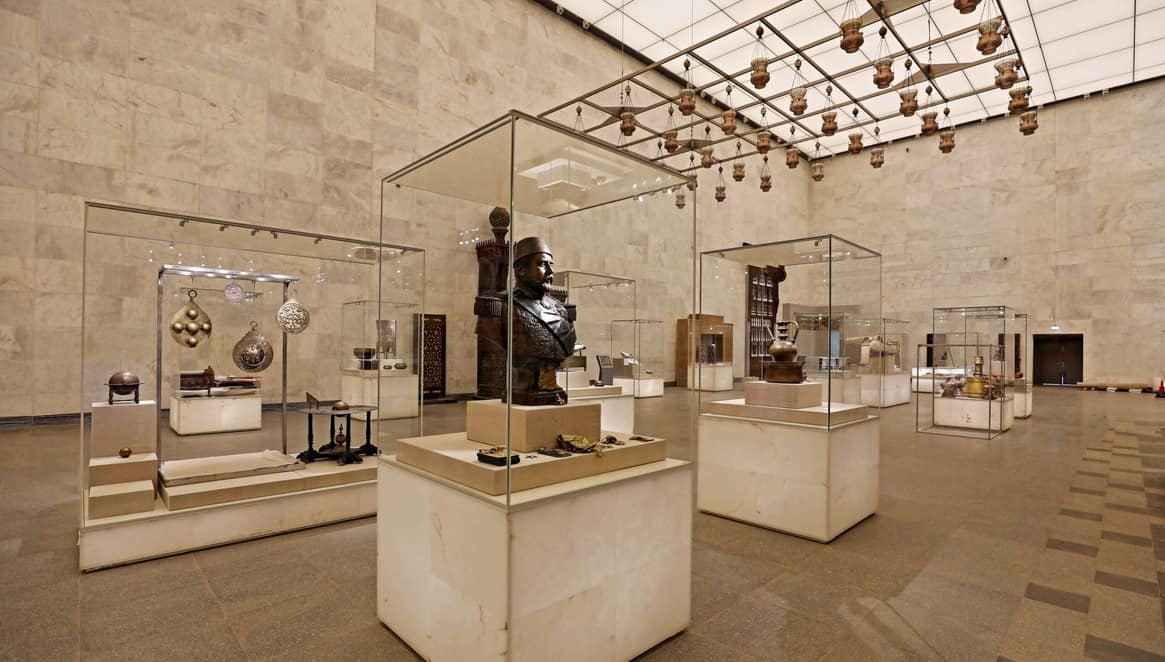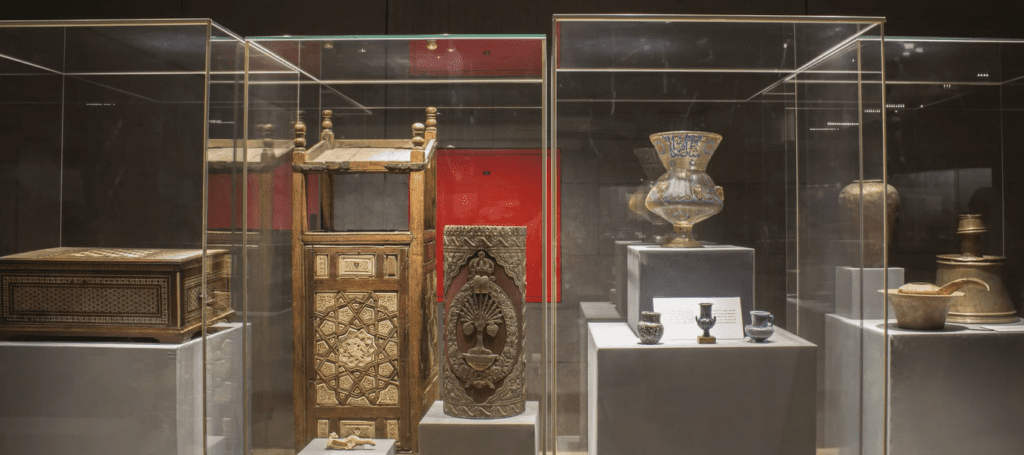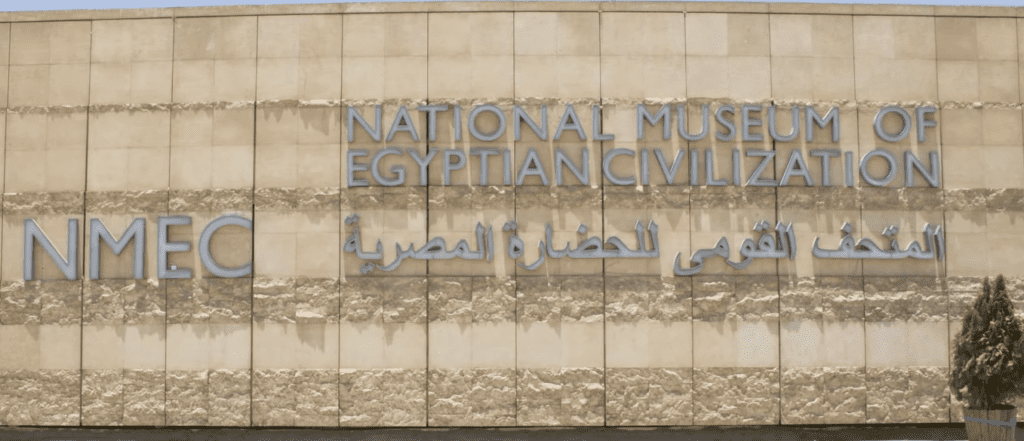The Amazing National Museum of Egyptian Civilization: the Newest State of the Art Landmark

Updated On: April 18, 2024 by Yomna Salah
Stepping into the National Museum of Egyptian Civilization (NMEC) is akin to embarking on a transcendent journey through the annals of time. Situated majestically along the storied banks of the Nile in Cairo, this cultural bastion is a testament to Egypt’s rich and multifaceted heritage. With each artefact meticulously curated and every exhibit thoughtfully arranged, the NMEC unveils the intricate tapestry of Egyptian civilization, offering visitors an immersive exploration of millennia-old history, art, and culture. In this article, we delve into the depths of this venerable institution, tracing the contours of Egypt’s past while illuminating the enduring legacy that continues to captivate and inspire audiences from around the globe.
Establishment
In its essence, the National Museum of Egyptian Civilization was developed as a cooperative project between the Egyptian government and UNESCO, and it was implemented in 2004. The role of UNESCO in the project is to provide consultancy and expertise and build museum objectives with multi-disciplinary professionals, archaeologists, architects, designers, educators, environmentalists, and administrators. The museum is considered the latest addition to Egyptian landmarks. It opened in February 2017, and many things can be seen inside.
As soon as visitors arrive at the museum, they won’t help but notice the architectural design of the buildings that feature aspects of the Egyptian civilization, such as the glass pyramid on top of the main building and the Roman/Egyptian theatre.
The museum received its first batch of a treasured collection in June 2015. The batch included ten artefacts carefully selected from the store galleries of the Saqqara necropolis, which show limestone reliefs engraved with scenes depicting the daily and religious life of ancient Egyptians and an 18th dynasty army leader before becoming a king.
Moreover, perhaps the most important artefacts are a collection of prehistoric clay pots, the royal chair of Hetepheres, the mother of King Khufu, and a small ancient Egyptian stool carved from 120 wooden pieces. A Qabbati robe textile and set of Islamic doors decorated with foliage and geometric designs with ivory are also among the distinguished items to be displayed, along with jewellery from Siwa, Nubia, Upper and Lower Egypt.
Plans to create the NMEC began in 1982, and construction was finished in 2009. In 2000, its location right next to Lake Ain Al-Sira in Fustat was selected, and in 2002, the large, square foundation stone — the platform of the building’s stylised pyramid design — was installed.
Unfortunately, visitors only have the chance to visit the main and only exhibition hall for now. The upcoming two phases, containing four exhibition halls, will be ready by the end of 2019. An official from the museum stated that the first phase is done with, and the second phase is expected to be finalized in the summer of this year. This phase will include finalizing laboratories, the administrative and reception departments, the cinema, the theatre, commercial markets, and seminar halls. The entire museum will be completed in 2020 or by early 2021.
Exhibits at The National Museum of Egyptian Civilization

The museum will have a total of nine exhibition halls. These exhibition halls will feature galleries showcasing the archaic era, the medieval era, the Pharaonic era, the Greco-Roman period, the Coptic period, the Islamic period, the modern period, and the contemporary period in Egypt’s history. A collection of 50,000 Egyptian artefacts will be displayed there, but, of course, it will be divided according to the section it is related to.
As visitors further tour, they will find six featured topics that depict Egyptian civilization from early ages, including ‘The Nile’, which tracks down the use of the Nile River through Egyptian history in agriculture, fishing, and transport and how the Nile transformed through the years.
The second topic features ‘The Dawn of Civilization,’ where visitors can identify detailed aspects of the transformation of Egyptian civilization, which tackles aspects such as education, region formation, and stability.
The third topic, ‘Writing and Science’, features the latest archaeological discoveries that prove that Egyptians established the oldest forms of writing over 300 years ago. The fourth topic, ‘Material Culture’, showcases sculpture and photography, jewellery, decorations, and musical instruments formed through the years.
‘State and Society’ is the fifth topic visitors will encounter following the completion of the museum halls, which tracks down the state ruling system starting from the oldest state in Egypt.
The final featured topic, titled ‘Benefits and Beliefs, ’ highlights Egyptian beliefs and the formation of religion and confirms that Egyptians were never slaves of statues, according to NMEC’s official website.
The new Egyptian landmark has taken some collections from other museums in the country, such as the Egyptian Museum, the Coptic Museum, the Museum of Islamic Art, the Manial Palace and Museum in Cairo, as well as the Royal Jewelry Museum in Alexandria, all in effort to make NMEC the hub for Egyptian civilization like its counterparts in London, The British Museum and the Louvre in Paris.
Cultural Significance

Beyond its role as a repository of antiquities, the National Museum of Egyptian Civilization holds profound cultural significance for the people of Egypt and the global community alike. It symbolises national pride, celebrating Egypt’s enduring legacy as a cradle of civilization and a beacon of human achievement.
Moreover, the museum plays a pivotal role in fostering cultural exchange and dialogue, welcoming visitors from across the globe to explore the wonders of ancient Egypt. Through educational programs, outreach initiatives, and collaborative exhibitions, it seeks to promote greater understanding and appreciation of Egypt’s cultural heritage, transcending geographical and cultural boundaries.
Beyond the Pharaohs
While the pharaonic period undoubtedly looms large in Egypt’s collective consciousness, the NMEC also sheds light on lesser-known aspects of the country’s history. From the Graeco-Roman period to the Coptic era and beyond, the museum explores the cultural exchanges and influences that have shaped Egypt’s identity over the centuries.
One of the museum’s most captivating exhibits delves into ancient Egyptian craftsmanship, showcasing the exquisite artistry of artisans who adorned temples, tombs, and everyday objects with intricate designs and hieroglyphic inscriptions. Visitors can marvel at finely crafted statues, delicate jewellery, and ornate textiles, each bearing testimony to the skill and creativity of Egypt’s craftsmen.
The NMEC also celebrates Egypt’s contributions to science, medicine, and scholarship, highlighting the achievements of renowned figures such as Imhotep, the ancient physician and architect credited with designing the first pyramid, and Hypatia, the revered mathematician and philosopher who thrived in Alexandria during the late antiquity.
Educational Initiatives and Outreach
Beyond its role as a repository of artefacts, the National Museum of Egyptian Civilization is committed to educational initiatives and outreach programs to engage audiences of all ages. From guided tours and workshops to interactive learning experiences and scholarly symposiums, the museum seeks to inspire curiosity and foster a deeper understanding of Egypt’s past.
Through partnerships with schools, universities, and cultural institutions, the NMEC extends its reach beyond the confines of its physical space, bringing the wonders of ancient Egypt to audiences around the world. Digital initiatives, including virtual tours and online exhibitions, ensure the museum remains accessible to a global audience, transcending geographical boundaries and cultural barriers.
Preserving Egypt’s Cultural Heritage
Central to the mission of the NMEC is the preservation and conservation of Egypt’s cultural heritage for future generations. The museum employs state-of-the-art technologies and best practices in conservation to safeguard its vast collection of artefacts, ensuring that they remain accessible and intact for years to come.
In addition to its permanent exhibits, the NMEC hosts temporary exhibitions, educational programs, and outreach initiatives to engage audiences of all ages and backgrounds. Through partnerships with local communities, academic institutions, and international organizations, the museum seeks to foster a deeper appreciation for Egypt’s cultural heritage and promote cross-cultural dialogue and understanding.
Visitors to the NMEC can also take advantage of the museum’s research facilities and archives, which house a wealth of scholarly resources and historical documents. Scholars and researchers worldwide converge at the museum to study Egypt‘s past, contributing to our collective understanding of this ancient civilization.
Future Directions
As Egypt continues to embrace its cultural heritage in the 21st century, the National Museum of Egyptian Civilization stands poised to embark on new chapters of growth and innovation. Plans are underway to expand its collections, develop state-of-the-art conservation facilities, and enhance visitor amenities, ensuring it remains at the forefront of cultural institutions worldwide.
Furthermore, the museum’s role in safeguarding Egypt’s heritage has taken on added significance in light of ongoing challenges, including urbanization, climate change, and illicit trafficking of antiquities. By employing cutting-edge technologies and forging international partnerships, it endeavours to preserve and protect Egypt’s cultural treasures for future generations to cherish and explore.
Last Words
The National Museum of Egyptian Civilization stands as a beacon of Egypt’s rich and diverse heritage, inviting visitors on a journey through time that spans millennia of history and culture. From the monumental achievements of ancient pharaohs to the vibrant traditions of modern-day Egypt, the museum offers a comprehensive exploration of this fascinating civilization.
Through its world-class exhibits, educational programs, and conservation commitment, the NMEC is a guardian of Egypt’s cultural legacy, ensuring that it remains accessible and relevant for future generations. As visitors wander through its halls and galleries, they are transported to a bygone era, where the mysteries of the past come alive, and the wonders of Egypt await discovery.






